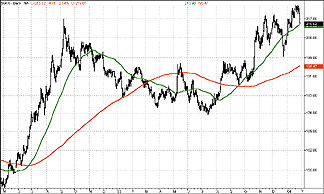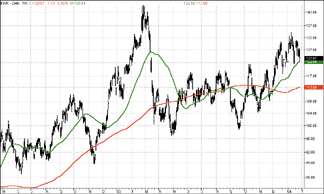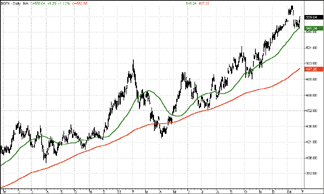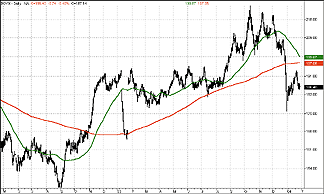GOLDMAN SACHS COMMODITIES INDEX The Goldman Sachs Commodities Index (GSCI) is a world production-weighted index of commodity prices based on the average quantity of production for the last five years of available data. The index is an appropriate benchmark against which the price performance of commodities can be judged. At the same time, the subgroups of the Goldman Sachs Commodities Index can also be used to measure the price performance of the various commodities that make up the GSCI. The weekly charts of the GSCI subgroups shown here include both the 50- and 200-day simple moving averages.
GSCI SUBGROUP: AGRICULTURE ($GKX)

The GSCI agriculture subgroup includes not only those commodities typically referred to as "the grains," but also many commodities generally included in the "softs" category. The subgroup's components include wheat, red wheat, corn, soybeans, cotton, sugar, coffee, cocoa, and orange juice.
In the summer of 2003, the agriculture subgroup emerged from a 10-month correction to establish multiyear highs by the first month of 2004. This bull market in agricultural commodities - again, including those typically referred to as "softs" - was confirmed in the autumn of 2003 by the crossing of the 50-day moving average up over the 200-day moving average. Except for a short, sharp correction to the index in December 2003, the 50-day moving average has provided significant support to the index's advance.
What they say: "America's amber waves of grain will have more than the usual gold tint about them this year, as a number of factors point to higher prices. World corn stocks are at a 30-year low, wheat stocks are at a 20-year low, and domestic soybean stocks are near a 30-year low. Meanwhile, demand - particularly for corn and soybeans - is buoyant. China is sucking up supplies and isn't likely to wrestle with the US in the corn-export market this year. And the US government surprised the industry by projecting a cut in 2004 winter-wheat plantings." - Lisa Kallal, "Climbing Plants," Commodities Corner, Barron's Online, January 26, 2004.
ENERGIES ($GJX)

The GSCI energies subgroup includes crude oil, Brent crude oil, unleaded gasoline, heating oil, and natural gas.
The energies subgroup began moving upward in the autumn of 2003. This rally emerged from a largely sideways correction that began in the spring of 2003, a correction that was the final stage of the collapse in energy commodity prices that occurred in February of that year. With the 50-day moving average breaking out above the 200-day moving average in December, the energies subgroup is at a higher level than at any time in recent years - save for the February price spike mentioned.
What they say: "The year 2003 was a challenge for Americans and for the petroleum industry. At the beginning of the year, we faced a cold winter, the shutdown of the Venezuelan oil industry, Nigerian strikes, and the anticipated Iraq war. These events precipitated a 'perfect storm' in petroleum and natural gas markets. Prices of petroleum products increased dramatically, reaching highs not experienced since the first Iraq war. As the conditions changed, prices declined." -- John C. Felmy, chief economist and director of policy analysis and statistics, American Petroleum Institute, January 14, 2004.
PRECIOUS METALS ($GPX)

The GSCI precious metals subgroup includes both gold and silver.
The precious metals subgroup has been the true star of the commodities indexes. Although this subgroup did dip below its 200-day moving average late in the spring of 2003, the precious metals subgroup has moved upward in a vigorous bull market ever since. The volatility of this subgroup is such that it has frequently dipped below its 50-day moving average. Nevertheless, the 50-day moving average has provided a significant amount of support to the precious metals subgroup's advance since the autumn of 2003.
What they say: "Debasing currencies around the globe (especially the dollar) and record-low interest rates also make silver, along with gold, an attractive investment for hedging against a decline in paper assets. Recognizing that the bear market in equities is far from over, combined with central banks that are injecting vast amounts of liquidity into the world financial system, currency debasement will accelerate, thereby making precious metals more attractive as an investment alternative." -- Jim Puplava, "Silver: The Undervalued Asset Looking For A Catalyst," Financial Sense Online's Storm Watch, July 2, 2003.
LIVESTOCK ($GVX)

The GSCI livestock subgroup includes both live and feeder cattle, as well as lean hogs.
The livestock subgroup broke out of a sideways correction early in the autumn of 2003 - a correction that began back in November 2002. It was in August 2003 that the 50- and 200-day moving averages converged and, though they did not cross and thus there was no breakout of the 50-day moving average over the 200-day, the 50-day moving average did accelerate to the upside shortly after this convergence as livestock prices surged. By December 2003, however, the livestock group was experiencing a correction that was every bit as sharp as the August 2003 rally. Although appearing to find some measure of support in the area of the November 2002-August 2003 consolidation range, the livestock subgroup remains below its 200-day moving average.
What they say: "The market's fear of mad cow was not that the US consumer would stop eating beef, but the reaction that importers of US beef would have to the report of the discovery in the state of Washington last month. Indeed, key US exporters Japan, South Korea, and Mexico have all slapped bans on US beef, at least for the time being. Exports account for near 10% of all US beef production, and thus, prices were forced to adjust accordingly." -- James Cordier, Liberty Trading Group, "Weak Dollar Favors Put Selling In Commodity Complex," January 13, 2004.
Originally published in the June 2004 issue of Technical Analysis of STOCKS & COMMODITIES magazine. All rights reserved. © Copyright 2004, Technical Analysis, Inc.
Return to June 2004 Contents